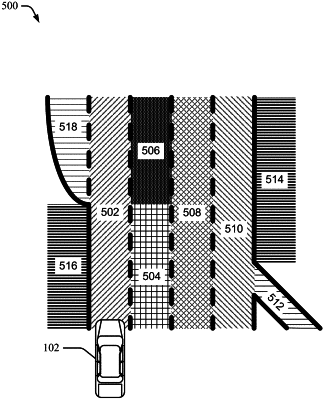| CPC B60W 40/072 (2013.01) [B60W 30/12 (2013.01); B60W 30/14 (2013.01); B60W 30/18018 (2013.01); B60W 60/001 (2020.02); G06V 20/582 (2022.01); G06V 20/588 (2022.01); B60W 2420/52 (2013.01); B60W 2552/53 (2020.02); B60W 2554/80 (2020.02)] | 20 Claims |

|
1. A method comprising:
defining, by a road-perception system of a vehicle and based on data from multiple information sources, lanes that comprise portions of a roadway, each of the lanes having multiple lane-type hypotheses, possible lane types of the multiple lane-type hypotheses including a through lane, a deceleration lane, a shoulder, an acceleration lane, or an ending lane, the multiple information sources including at least two of a map, a database, a vision sensor, a radar sensor, or a lidar sensor;
determining, by the road-perception system, respective belief masses associated with the multiple lane-type hypotheses for each of the lanes, the respective belief masses indicative of a confidence associated with the data from a particular information source contributing to classifying a respective lane to a respective lane-type hypothesis;
determining, by the road-perception system and using the respective belief masses associated with the multiple lane-type hypotheses for each of the lanes, a respective belief parameter and a plausibility parameter associated with each lane-type hypothesis, the belief parameter indicative of a confidence in a lane-type classification for each of the lanes and determined as a first sum of mass values that belong to the respective lane-type hypothesis to provide a lower bound, the plausibility parameter indicative of a likelihood of the lane-type classification being applicable to each of the lanes and determined as one minus a second sum of mass values whose intersection with the respective lane-type hypothesis is empty to provide an upper bound;
consolidating, by the road-perception system and using one of a product-based frame-of-discernment formulation method, a union-based frame-of-discernment formulation method, or a focal-elements-based frame-of-discernment formulation method, the multiple lane-type hypotheses for each of the lanes into at least one roadway hypothesis for the roadway, each roadway hypothesis representing a unique set of lane-type hypotheses for each of the lanes in the roadway, each roadway hypothesis satisfying properties of the Dempster-Shafer Theory and Dempster-Shafer fusion rules;
determining, by the road-perception system and using the respective belief parameter and plausibility parameter associated with the multiple lane-type hypotheses for each of the lanes, a belief parameter and a plausibility parameter associated with each of the at least one roadway hypothesis;
determining whether the belief parameter and the plausibility parameter associated with at least one roadway hypothesis are each greater or less than a respective threshold value; and
responsive to determining that the belief parameter and the plausibility parameter of the at least one roadway hypothesis are each greater than the respective threshold value, using the at least one roadway hypothesis as an input to an autonomous-driving system or an assisted-driving system that operates the vehicle on the roadway.
|